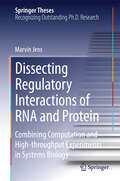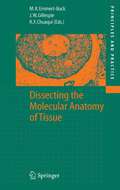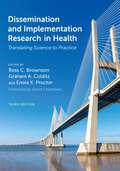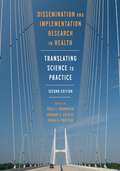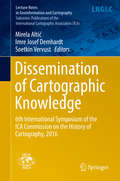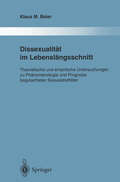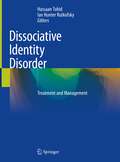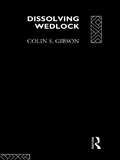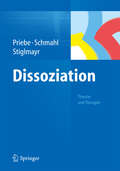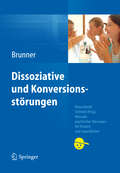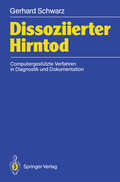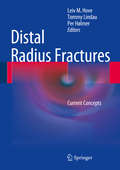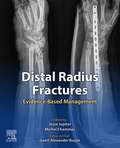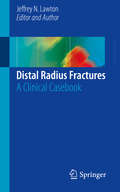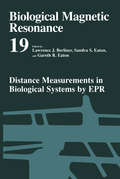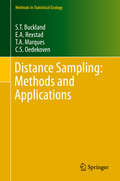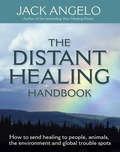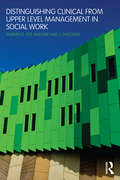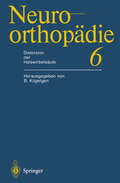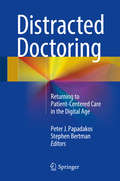- Table View
- List View
Dissecting Regulatory Interactions of RNA and Protein: Combining Computation and High-throughput Experiments in Systems Biology (Springer Theses)
by Marvin JensThe work described in this book is an excellent example of interdisciplinary research in systems biology. It shows how concepts and approaches from the field of physics can be efficiently used to answer biological questions and reports on a novel methodology involving creative computer-based analyses of high-throughput biological data. Many of the findings described in the book, which are the result of collaborations between the author (a theoretical scientist) and experimental biologists and between different laboratories, have been published in high-quality peer-reviewed journals such as Molecular Cell and Nature. However, while those publications address different aspects of post-transcriptional gene regulation, this book provides readers with a complete, coherent and logical view of the research project as a whole. The introduction presents post-transcriptional gene regulation from a distinct angle, highlighting aspects of information theory and evolution and laying the groundwork for the questions addressed in the subsequent chapters, which concern the regulation of the transcriptome as the primary functional carrier of active genetic information.
Dissecting the Molecular Anatomy of Tissue (Principles and Practice)
by Michael R. Emmert-Buck John W. Gillespie Rodrigo F. ChuaquiThe book provides an updated overview of molecular analysis of human tissues, and the impact this analysis has on diagnosis and prognosis of human diseases. Special emphasis is placed on human cancer and the future directions of the field. Methods of handling clinical tissue samples, including the impact of handling on subsequent molecular analysis, are also discussed. In addition, detailed protocols for molecular analysis of DNA, RNA and protein, with special emphasis on molecular analysis of highly complex human tissue samples containing mixtures of cell populations, are provided.
Dissemination and Implementation Research in Health: Translating Science to Practice
by Ross C. Brownson, Graham A. Coldi TZ, Enola K. ProctorThe ultimate guide to dissemination and implementation research for public health, medicine, and the social sciences In the past twenty years, dissemination and implementation (D&I) research has sought to narrow the gap between the discovery of new knowledge and its application in public health, mental health, and health care settings. The challenges of moving research to practice and policy are universal, and future progress calls for collaborative partnerships and cross-country research. The fundamental tenet of D&I research-taking what we know about improving health and putting it into practice-must be the highest priority. Dissemination and Implementation Research in Health is the definitive roadmap to effecting change in health and science from today's leading D&I researchers. With insights from around the globe, these scholars collectively address key issues in the field including how to evaluate evidence based on effective interventions, how to design an appropriate study, and how to track a set of essential outcomes. Their work has been updated in this third edition with a strong focus on health equity and new chapters on de-implementation, scale-up and sustainment, and training and capacity building. This new edition also focuses on barriers to uptake of evidence-based interventions in the communities where people live their lives and from the social service agencies, hospitals, and clinics where they receive care. Now in its third edition, Dissemination and Implementation Research in Health remains the quintessential guide to making research more consequential for researchers and practitioners in health and the social sciences.
Dissemination and Implementation Research in Health: Translating Science to Practice
by Ross C. Brownson, Graham A. Colditz and Enola K. ProctorThe definitive work in D&I research -- now completely updated and expanded The application of scientific research to the creation of evidence-based policies is a science unto itself -- and one that is never easy. Dissemination and implementation research (D&I) is the study of how scientific advances can be implemented into everyday life, and understanding how it works has never been more important for students and professionals across the scientific, academic, and governmental communities. DISSEMINATION AND IMPLEMENTATION RESEARCH IN HEALTH is a practical guide to making research more consequential, a collection assembled and written by today's leading D&I researchers. Readers of this book are taught to: · Evaluate the evidence base in an effective intervention · Choose a strategy that produces the greatest impact · Design an appropriate and effectual study · Track essential outcomes · Account for the barriers to uptake in communities, social service agencies, and health care facilities The challenges to moving research into practice are universal, and they're complicated by the current landscape's reliance on partnerships and multi-center research. In this light, DISSEMINATION AND IMPLEMENTATION RESEARCH IN HEALTH is nothing less than a roadmap to effecting change in the sciences. It will have broad utility to researchers and practitioners in epidemiology, biostatistics, behavioral science, economics, medicine, social work, psychology, and anthropology -- both today and in our slightly better future.
Dissemination and Implementation Research in Health: Translating Science to Practice
The definitive work in D&I research -- now completely updated and expanded The application of scientific research to the creation of evidence-based policies is a science unto itself -- and one that is never easy. Dissemination and implementation research (D&I) is the study of how scientific advances can be implemented into everyday life, and understanding how it works has never been more important for students and professionals across the scientific, academic, and governmental communities. DISSEMINATION AND IMPLEMENTATION RESEARCH IN HEALTH is a practical guide to making research more consequential, a collection assembled and written by today's leading D&I researchers. Readers of this book are taught to: · Evaluate the evidence base in an effective intervention · Choose a strategy that produces the greatest impact · Design an appropriate and effectual study · Track essential outcomes · Account for the barriers to uptake in communities, social service agencies, and health care facilities The challenges to moving research into practice are universal, and they're complicated by the current landscape's reliance on partnerships and multi-center research. In this light, DISSEMINATION AND IMPLEMENTATION RESEARCH IN HEALTH is nothing less than a roadmap to effecting change in the sciences. It will have broad utility to researchers and practitioners in epidemiology, biostatistics, behavioral science, economics, medicine, social work, psychology, and anthropology -- both today and in our slightly better future.
Dissemination and Implementation Research in Health: Translating Science to Practice
The ultimate guide to dissemination and implementation research for public health, medicine, and the social sciences In the past twenty years, dissemination and implementation (D&I) research has sought to narrow the gap between the discovery of new knowledge and its application in public health, mental health, and health care settings. The challenges of moving research to practice and policy are universal, and future progress calls for collaborative partnerships and cross-country research. The fundamental tenet of D&I research-taking what we know about improving health and putting it into practice-must be the highest priority. Dissemination and Implementation Research in Health is the definitive roadmap to effecting change in health and science from today's leading D&I researchers. With insights from around the globe, these scholars collectively address key issues in the field including how to evaluate evidence based on effective interventions, how to design an appropriate study, and how to track a set of essential outcomes. Their work has been updated in this third edition with a strong focus on health equity and new chapters on de-implementation, scale-up and sustainment, and training and capacity building. This new edition also focuses on barriers to uptake of evidence-based interventions in the communities where people live their lives and from the social service agencies, hospitals, and clinics where they receive care. Now in its third edition, Dissemination and Implementation Research in Health remains the quintessential guide to making research more consequential for researchers and practitioners in health and the social sciences.
Dissemination of Cartographic Knowledge: 6th International Symposium of the ICA Commission on the History of Cartography, 2016 (Lecture Notes in Geoinformation and Cartography)
by Mirela Altić Imre Josef Demhardt Soetkin VervustThis book gathers 22 papers which were presented at the 6th International Symposium of the ICA Commission on the History of Cartography in Dubrovnik, Croatia on 13–15 October 2016. The overall conference theme was ‘The Dissemination of Cartographic Knowledge: Production – Trade – Consumption – Preservation’. The book presents original research by internationally respected authors in the field of historical cartography, offering a significant contribution to the development of this field of study, but also of geography, history and the GIS sciences. The primary target audience includes researchers, educators, postgraduate students, map librarians and archivists.
Dissexualität im Lebenslängsschnitt: Theoretische und empirische Untersuchungen zu Phänomenologie und Prognose begutachteter Sexualstraftäter (Monographien aus dem Gesamtgebiete der Psychiatrie #78)
by Klaus M. BeierDissociative Identity Disorder: Treatment and Management
by Hassaan Tohid Ian Hunter RutkofskyThis book contains new evidence and more ideas for treatment and management of dissociative identity disorder (DID). It is written from the standpoint of an expert in the field for other professionals that deal with or are interested in DID. Chapters are divided into 4 parts. Part 1 acts as an introduction to understanding dissociative identity disorder, such its history, the different types of the disorder, and its portrayal in popular culture. The chapters in this part cover multiple personality disorder, theories, and epidemiology of the disease. Part 2 discusses the pathology and neuroscience of the disease. The comorbidities related to the disorder will be explained, such as PTSD, depression, anxiety, schizophrenia, and more. This part concludes with the potential causes of dissociative identity disorder, which ties into the previously mentioned comorbidities throughout this part. Supplementing the aforementioned topics, Part 3 discusses management of the disease. The chapters will cover modern psychiatry, diagnosis, and treatment options. Drug treatment and psychotherapy are some examples of the treatment options available. The authors share their experiences and perspectives of managing DID, including clinical trials and recovery. Finally, Part 4 discusses the sociology of DID, such as potential drug abuse, social media presence, and the difficulties that psychiatrists face in diagnosing the disease. This part provides advice for clinicians and healthcare providers by sharing different perspectives from psychiatrists that encounter the disease. Written by experts in the field, Dissociative Identity Disorder serves as a valuable resource for psychiatrists and clinicians seeking to understand, treat, and manage the disease.
Dissolving Wedlock
by Dr Colin Gibson Colin GibsonThe divorce rate has been rising significantly throughout the twentieth century. By interweaving the historical, demographic, sociological, legal, political and policy aspects of this increase, Colin Gibson explores the effects it has had on family patterns and habits. Dissolving Wedlock presents a multi-disciplinary examination of all the socio-legal consequences of family breakdown. Dissolving Wedlock will be invaluable reading to all lecturers and students of social policy, sociology and social work as well as to professionals and lawyers working in the field of divorce.
Dissolving Wedlock
by Dr Colin Gibson Colin GibsonThe divorce rate has been rising significantly throughout the twentieth century. By interweaving the historical, demographic, sociological, legal, political and policy aspects of this increase, Colin Gibson explores the effects it has had on family patterns and habits. Dissolving Wedlock presents a multi-disciplinary examination of all the socio-legal consequences of family breakdown. Dissolving Wedlock will be invaluable reading to all lecturers and students of social policy, sociology and social work as well as to professionals and lawyers working in the field of divorce.
Dissoziation: Theorie und Therapie
by Kathlen Priebe Christian Schmahl Christian StiglmayrWenngleich dissoziative Symptome und Störungen häufig auftreten, werden sie im klinischen Alltag sehr oft nicht erkannt und behandelt. Psychotherapeutische Ansätze zur Behandlung von Dissoziation finden sich kaum, so dass sich viele Kliniker mit dieser Symptomatik unsicher fühlen. Dieses Buch gibt einen vollständigen und aktuellen Überblick über dissoziative Symptome und Störungen; es beschreibt, wie sie sich ausprägen und was man therapeutisch tun kann. Im 1. Teil werden Grundlagen dissoziativer Symptome und Störungen ausführlich dargestellt – von der Historie über die Klassifikation bis hin zu Erhebungsinstrumenten, Ätiologie und Neurobiologie. Der 2. Teil ist bestimmten psychiatrischen Störungsbildern gewidmet, bei denen Dissoziation häufig auftritt wie z.B. der Borderline-Persönlichkeitsstörung, der posttraumatischen Belastungsstörung, aber auch der Schizophrenie. Im 3. Teil wird zunächst die Datenlage zu psychotherapeutischen und pharmakotherapeutischen Ansätzen überblickartig dargestellt. Schließlich wird ein Therapieleitfaden zur Behandlung verschiedenster dissoziativer Symptome und Störungen beschrieben. Der modulare Aufbau des Leitfadens erlaubt es, das spezifische Vorgehen in der Therapie zu individualisieren. Bei komorbider Symptomatik können die Therapiemodule in einen Gesamtbehandlungsplan integriert werden. - Aktuell und wissenschaftlich fundiert - Überblick für Wissenschaftler und Kliniker - Beschreibung dissoziativer Symptome und Störungen - Störungsübergreifender modularer Therapieansatz - Praxisorientiert mit vielen Fallbeispielen und Arbeitsblättern
Dissoziative und Konversionsstörungen (Manuale psychischer Störungen bei Kindern und Jugendlichen)
by Romuald M. BrunnerDissoziative Störungen zeigen sich u. a. in der Störung der integrativen Funktion der Identität, des Gedächtnisses und des Bewusstseins. Gerade bei Kindern kann die Zuordnung der Symptome schwierig sein. Der Band aus der Reihe „Psychische Störungen im Kindes- und Jugendalter" bereitet alles Wissenswerte zu Diagnostik und Therapie praxisnah auf. Die Reihe verfolgt einen Ansatz, bei dem der Patient im Mittelpunkt steht und Behandelnde aufgefordert sind, über den Tellerrand zu blicken. Mit Tipps für Betroffene, um den Alltag besser meistern zu können.
Dissoziierter Hirntod: Computergestützte Verfahren in Diagnostik und Dokumentation
by Gerhard SchwarzDie vorliegende Monographie behandelt die mehrschichtige Problematik "Hirntod" aus unterschiedlicher Warte. Den Schwerpunkt bildet die Beschreibung wie neue Entwicklungen der Medizintechnik und medizinischen Informatik f}r die Bestimmung des Hirntodes umgesetzt werden.
Distal Radius Fractures: Current Concepts
by Leiv M. Hove Tommy Lindau Per HølmerThis textbook aims to provide the reader with a complete understanding of distal radius fractures, their inherent problems, and how to manage them successfully. It is written by widely published experts from a part of the globe where distal radius fractures are very common, especially during the winter months. Clear guidance is provided on diagnostic imaging, classification, and assessment of fracture instability. The complete spectrum of operative and nonoperative treatment options are then clearly explained with the aid of step-by-step illustrations. Extensive information is also provided on complications and their treatment. Both students and experienced practitioners will find this book to be an enlightening, practice-oriented reference on the management of these challenging fractures.
Distal Radius Fractures: Evidence-Based Management
by Jesse Jupiter Michel ChammasEdited and authored by leading international experts, Distal Radius Fractures: Evidence-Based Management provides a state-of-the-art overview of diagnosis and management based on today’s best practices. Each chapter focuses on one key issue, offering a challenging case and then questioning the reader in an engaging fashion to provide the best available evidence on each topic. Practical and easy to read, this innovative text is a useful resource for all residents, physicians and surgeons who manage fractures. Combines current best practices with the knowledge and experience of a global team of expert contributing authors, with a focus on practical use in applying the evidence. Covers need-to-know topics such as anatomy and biomechanics, diagnostic management, acute fracture management, management of pediatric and elderly fractures, and more. Includes valuable case scenarios, technical tips and tricks, and pearls and pitfalls. Features high-quality illustrations including CT scans, x-rays, and clinical photographs. Consolidates the latest evidence on distal radius fractures into one convenient resource.
Distal Radius Fractures: A Clinical Casebook
by Jeffrey N. LawtonBased exclusively upon clinical cases covering fractures of the distal radius, this concise, practical casebook will provide orthopedic surgeons and sports medicine specialists with the best real-world strategies to properly manage the multifaceted surgical techniques for management of the distal radius and distal radial ulnar joint (DRUJ). Each chapter begins with a case that opens with a unique clinical presentation, followed by a description of the diagnosis, assessment and management techniques used to treat it, as well as the case outcome and clinical pearls and pitfalls. Cases included illustrate the various uses of the volar locking plate for metaphyseal and periarticular fractures, among others, as well as management strategies for open reduction internal fixation (ORIF) for the radial styloid. Ulnar styloid and ulnar head/neck fractures are likewise described. Pediatric distal radius fractures and complications round out the presentation. Pragmatic and reader friendly, Distal Radius Fractures: A Clinical Casebook will be an excellent resource for orthopedic surgeons, hand and upper extremity surgeons and sports medicine specialists confronted with both common and complex fractures to the distal radius and DRUJ.
Distance Measurements in Biological Systems by EPR (Biological Magnetic Resonance #19)
by Lawrence J. Berliner Gareth R. Eaton Sandra S. EatonDistance measurements in biological systems by EPR The foundation for understanding function and dynamics of biological systems is knowledge of their structure. Many experimental methodologies are used for determination of structure, each with special utility. Volumes in this series on Biological Magnetic Resonance emphasize the methods that involve magnetic resonance. This volume seeks to provide a critical evaluation of EPR methods for determining the distances between two unpaired electrons. The editors invited the authors to make this a very practical book, with specific numerical examples of how experimental data is worked up to produce a distance estimate, and realistic assessments of uncertainties and of the range of applicability, along with examples of the power of the technique to answer biological problems. The first chapter is an overview, by two of the editors, of EPR methods to determine distances, with a focus on the range of applicability. The next chapter, also by the Batons, reviews what is known about electron spin relaxation times that are needed in estimating distances between spins or in selecting appropriate temperatures for particular experiments. Albert Beth and Eric Hustedt describe the information about spin-spin interaction that one can obtain by simulating CW EPR line shapes of nitroxyl radicals. The information in fluid solution CW EPR spectra of dual-spin labeled proteins is illustrated by Hassane Mchaourab and Eduardo Perozo.
Distance Sampling: Methods and Applications (Methods in Statistical Ecology)
by S. T. Buckland E.A. Rexstad T.A. Marques C.S. OedekovenIn this book, the authors cover the basic methods and advances within distance sampling that are most valuable to practitioners and in ecology more broadly. This is the fourth book dedicated to distance sampling. In the decade since the last book published, there have been a number of new developments. The intervening years have also shown which advances are of most use. This self-contained book covers topics from the previous publications, while also including recent developments in method, software and application.Distance sampling refers to a suite of methods, including line and point transect sampling, in which animal density or abundance is estimated from a sample of distances to detected individuals. The book illustrates these methods through case studies; data sets and computer code are supplied to readers through the book’s accompanying website. Some of the case studies use the software Distance, while others use R code. The book is in three parts. The first part addresses basic methods, the design of surveys, distance sampling experiments, field methods and data issues. The second part develops a range of modelling approaches for distance sampling data. The third part describes variations in the basic method; discusses special issues that arise when sampling different taxa (songbirds, seabirds, cetaceans, primates, ungulates, butterflies, and plants); considers advances to deal with failures of the key assumptions; and provides a check-list for those conducting surveys.
The Distant Healing Handbook: How to send healing to people, animals, the environment and global trouble spots
by Jack AngeloTHE DISTANT HEALING HANDBOOK is an important book from the UK's leading healing teacher, Jack Angelo. Jack explains that we all have it in our power to take action, to reach out and help people, places and animals who are in need. Extraordinary case histories reveal the beneficial effect distant healing can have. Step-by-step, using over 60 easy-to-follow exercises, Jack shows you how to access your own distant healing power and harness your love and energy for the good of others. THE DISTANT HEALING HANDBOOK will enable you to: Sense your energy field and send healing to people at any distance; Work on your own or with a group or healing circle; Learn advanced, astral level healing; Work with the environment, plants and animals; Send light to trouble spots and disaster areas around the world; Practise unconditional love and bring healing into your everyday life. THE DISTANT HEALING HANDBOOK is a book everyone can use, whether you already have a healing gift or whether you simply want to learn how to send healing and make a difference to a loved one, a pet or to the world we live in.
Distinctiveness and Memory
by R. Reed Hunt James B. WorthenResearch relevant to the topic of distinctiveness and memory dates back over 100 years and boasts a literature of well over 2,000 published articles. Throughout this history, numerous theories of distinctiveness and memory have been offered and subsequently refined. There has, however, never been a book that brings this rich history together with the latest research. This volume is the first to present an historical overview, the results of the current research, and several new theories on distinctiveness and memory. Each chapter contains a review of the relevant literature and latest research on its topic. The book includes sections that cover basic theory and behavioral research on distinctiveness, bizarreness effects, distinctiveness effects on implicit memory, the development of distinctiveness across the lifespan, distinctiveness in social context, and the neuroscience of distinctiveness and memory. In the concluding chapter, Fergus Craik offers his current perspective on distinctiveness and evaluates the various other theories of distinctiveness presented in the volume. Distinctiveness and Memory will be a valuable resource for student and professional researchers in neuroscience and cognitive, developmental, and social psychology.
Distinguishing Clinical from Upper Level Management in Social Work
by Marvin D. Feit Michael J. HoloskoOver the past few decades, as administrative and technological complexity has increased, so has the role and importance of administrative practice in social work. For those making the switch from front-line practice to administration and management there is, therefore, a real need to prepare and enhance the knowledge base and skill set necessary at the executive level. In particular, the importance of budgeting and fiscal management, the need for accountability, negotiation between different and competing organizations, along with an understanding of decision-making, planning, and understanding levels of risk. Written by two experienced authors within social work education, this practical workbook presents the interrelated nature of decision-making, and provides a model for understanding what is required in the transition from clinician, to clinical and upper level management. The text covers: The difference between clinical and upper level management skills The major trends that influence health and human service organizations An analysis of the concept of leadership The skills needed by Clinical Managers and Upper Level Managers to administer effectively. Distinguishing Clinical and Upper Level Management is a much needed update to the field of management and administration within human service organizations, and will be important reading for social work students, social service professionals, and other human service providers.
Distinguishing Clinical from Upper Level Management in Social Work
by Marvin D. Feit Michael J. HoloskoOver the past few decades, as administrative and technological complexity has increased, so has the role and importance of administrative practice in social work. For those making the switch from front-line practice to administration and management there is, therefore, a real need to prepare and enhance the knowledge base and skill set necessary at the executive level. In particular, the importance of budgeting and fiscal management, the need for accountability, negotiation between different and competing organizations, along with an understanding of decision-making, planning, and understanding levels of risk. Written by two experienced authors within social work education, this practical workbook presents the interrelated nature of decision-making, and provides a model for understanding what is required in the transition from clinician, to clinical and upper level management. The text covers: The difference between clinical and upper level management skills The major trends that influence health and human service organizations An analysis of the concept of leadership The skills needed by Clinical Managers and Upper Level Managers to administer effectively. Distinguishing Clinical and Upper Level Management is a much needed update to the field of management and administration within human service organizations, and will be important reading for social work students, social service professionals, and other human service providers.
Distracted Doctoring: Returning to Patient-Centered Care in the Digital Age
by Peter J. Papadakos Stephen BertmanExamining-room computers require doctors to record detailed data about their patients, yet reduce the time clinicians can spend listening attentively to the very people they are trying to help. This book presents original essays by distinguished experts in their fields, addressing this critical problem and making an urgent case for reform, because while electronic technology has revolutionized the practice of medicine, it also poses a unique challenge to health care. Smartphones in the hands of doctors and nurses have become dangerously seductive devices that can endanger their patients. Distracted Doctoring is written for anesthesiologists and surgeons, as well as general practitioners, nurses, and health care administrators and students. Chapters include Electronic Challenges to Patient Safety and Care; Distraction, Disengagement, and the Purpose of Medicine; and Managing Distractions through Advocacy, Education, and Change.
